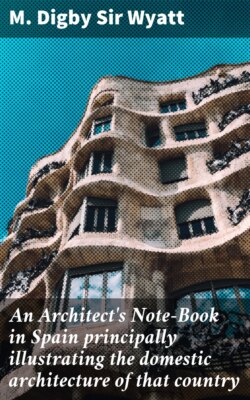Читать книгу An Architect's Note-Book in Spain principally illustrating the domestic architecture of that country - Sir M. Digby Wyatt - Страница 26
На сайте Литреса книга снята с продажи.
LEON. EXTERIOR OF THE CASA DE LOS GUSMANES.
ОглавлениеIN an ancient house which stood upon the site on which now stands the Palace which forms the subject of our sketch, there was born, in the year 1266, a "Cavalier," who, when arrived at manhood, followed the fortunes of Sancho the Brave. After many struggles, the King having taken Tarifa in Andalucia from the Moors in 1292, looked round amongst his followers for one willing to hold what he had won. All refused, owing to the danger of the position, until Alonso Perez de Guzman, the Cavalier in question, offered to keep possession of the town for a year. The story is thus condensed by Ford, from the "Romancero." The Moors beleaguered it, aided by the Infante Juan, a traitor brother of Sancho's to whom Alonso's eldest son, aged nine, had been entrusted previously as a page. "Juan now brought the boy under the walls, and threatened to kill him if his father would not surrender the place. Alonso drew his dagger and threw it down exclaiming, 'I prefer honour without a son, to a son with dishonour.' He retired, and the Prince caused the child to be put to death. A cry of horror ran through the Spanish battlements. Alonso rushed forth, beheld his son's body, and returning to his childless mother, calmly observed, 'I feared that the infidel had gained the city.' Sancho, the King, likened him to Abraham, from this parental sacrifice and honoured him with the 'canting' name 'El Bueno.' The good (Guzman, Gutman, Goodman.) He became the founder of the princely Dukes of Medina Sidonia, now merged by marriage in the Villafrancas." From this great head descended ultimately Her Majesty the Empress Eugénie of France. Gaining strength, riches and power, the original residence of El Bueno became too small for his aspiring family, and in 1560, Don Juan Quiñones y Guzman, Bishop of Calahorra, determined upon the erection, on the same site, of the present fine structure. The name of the architect does not seem to be known, but it is obviously the work of one who, rejecting the elaboration of the Plateresque style, followed the simpler and more chastened proportions recommended by the early Italian writers on architecture, such as Alberti and Serlio, and by the first Spanish student of Vitruvius, Diego Sagredo in his "Medidas del Romano," (Toledo, 1526.)
It is probable that the use of a large quantity of iron externally, as in the balconies and other parts of this Palace was somewhat of a novelty at the date of construction, since the story runs "that when Philip II. visited Leon, as his courtiers, some friends of the Bishops, were praising the building, and were mentioning in a friendly way the thousands of cwts. of iron employed in it, the King severely observed, punningly by the way, 'En verdad que ha sido mucho yerro para un obispo.'"[10] The pun turns upon the word yerro which means both iron, and a mistake. The joke would have been unworthy of Philip II. if it had not been grim.
